Pearson BTEC Financial Accounting Assignment: Unit 10 Analysis
VerifiedAdded on 2022/02/14
|33
|9501
|49
Report
AI Summary
This assignment is a comprehensive financial accounting report covering key concepts and practical applications. It begins with an analysis of double-entry bookkeeping, including journal entries and ledger postings for a sole trader. The report then delves into the importance of trial balances, attributes of quality accounting information, and relevant regulations. Students are required to prepare a trial balance and an adjusted trial balance, incorporating adjusting entries for unbilled revenue, depreciation, insurance, and salaries. The assignment extends to preparing final accounts from the adjusted trial balance. Furthermore, the report analyzes the differences between financial reports and financial accounting, discusses different types of financial statements, and explains accounting principles like consistency, materiality, and full disclosure. Activities include preparing final accounts for a limited company. The assignment also addresses bank reconciliation, explaining its necessity and process, and includes a bank reconciliation statement. Finally, the report covers control accounts, suspense accounts, and their role in financial accounting, including the preparation of a sales ledger control account and its reconciliation with the sales ledger balance.
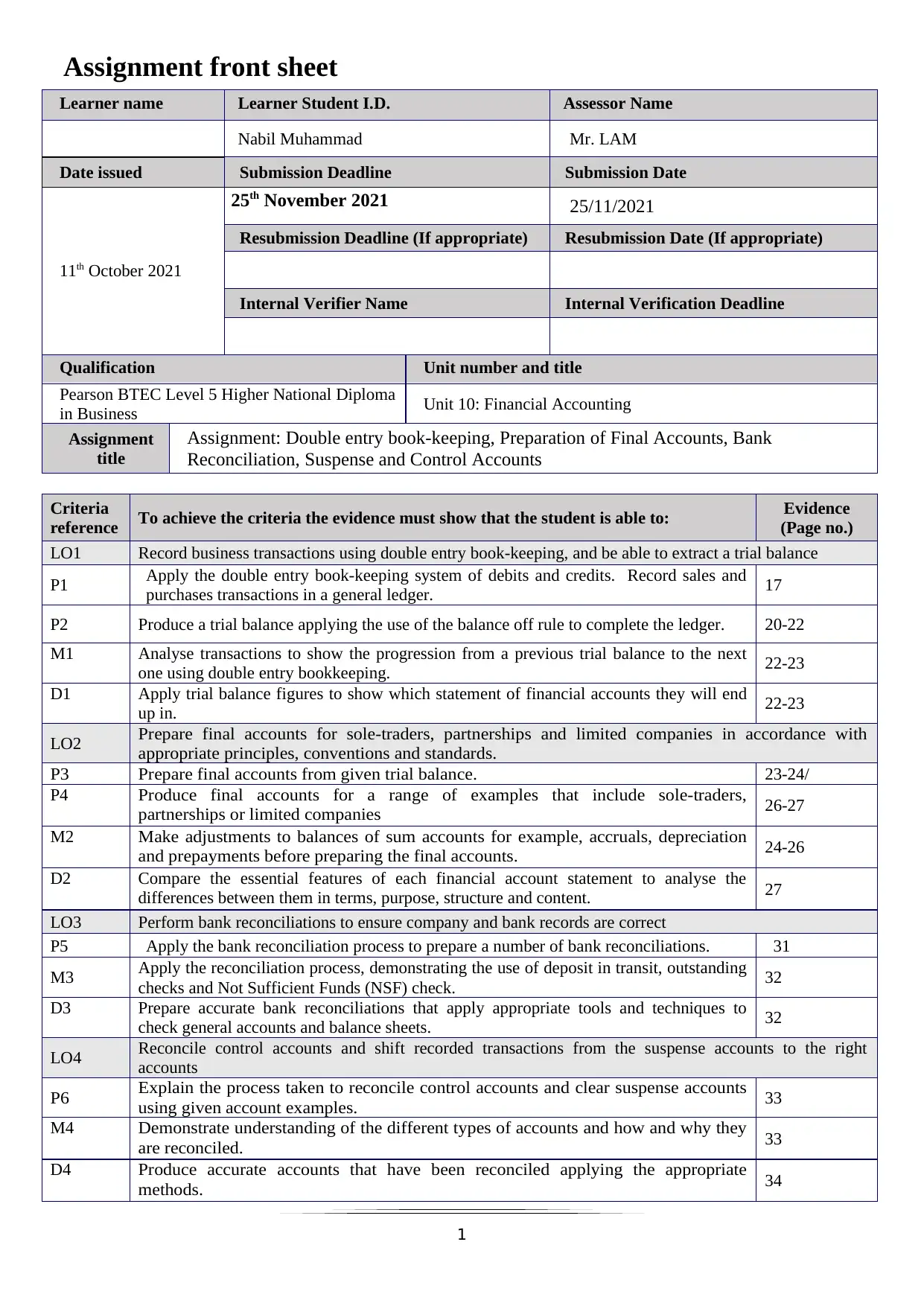
Assignment front sheet
Learner name Learner Student I.D. Assessor Name
Nabil Muhammad Mr. LAM
Date issued Submission Deadline Submission Date
11th October 2021
25th November 2021 25/11/2021
Resubmission Deadline (If appropriate) Resubmission Date (If appropriate)
Internal Verifier Name Internal Verification Deadline
Qualification Unit number and title
Pearson BTEC Level 5 Higher National Diploma
in Business Unit 10: Financial Accounting
Assignment
title
Assignment: Double entry book-keeping, Preparation of Final Accounts, Bank
Reconciliation, Suspense and Control Accounts
Criteria
reference To achieve the criteria the evidence must show that the student is able to: Evidence
(Page no.)
LO1 Record business transactions using double entry book-keeping, and be able to extract a trial balance
P1 Apply the double entry book-keeping system of debits and credits. Record sales and
purchases transactions in a general ledger. 17
P2 Produce a trial balance applying the use of the balance off rule to complete the ledger. 20-22
M1 Analyse transactions to show the progression from a previous trial balance to the next
one using double entry bookkeeping. 22-23
D1 Apply trial balance figures to show which statement of financial accounts they will end
up in. 22-23
LO2 Prepare final accounts for sole-traders, partnerships and limited companies in accordance with
appropriate principles, conventions and standards.
P3 Prepare final accounts from given trial balance. 23-24/
P4 Produce final accounts for a range of examples that include sole-traders,
partnerships or limited companies 26-27
M2 Make adjustments to balances of sum accounts for example, accruals, depreciation
and prepayments before preparing the final accounts. 24-26
D2 Compare the essential features of each financial account statement to analyse the
differences between them in terms, purpose, structure and content. 27
LO3 Perform bank reconciliations to ensure company and bank records are correct
P5 Apply the bank reconciliation process to prepare a number of bank reconciliations. 31
M3 Apply the reconciliation process, demonstrating the use of deposit in transit, outstanding
checks and Not Sufficient Funds (NSF) check. 32
D3 Prepare accurate bank reconciliations that apply appropriate tools and techniques to
check general accounts and balance sheets. 32
LO4 Reconcile control accounts and shift recorded transactions from the suspense accounts to the right
accounts
P6 Explain the process taken to reconcile control accounts and clear suspense accounts
using given account examples. 33
M4 Demonstrate understanding of the different types of accounts and how and why they
are reconciled. 33
D4 Produce accurate accounts that have been reconciled applying the appropriate
methods. 34
1
Learner name Learner Student I.D. Assessor Name
Nabil Muhammad Mr. LAM
Date issued Submission Deadline Submission Date
11th October 2021
25th November 2021 25/11/2021
Resubmission Deadline (If appropriate) Resubmission Date (If appropriate)
Internal Verifier Name Internal Verification Deadline
Qualification Unit number and title
Pearson BTEC Level 5 Higher National Diploma
in Business Unit 10: Financial Accounting
Assignment
title
Assignment: Double entry book-keeping, Preparation of Final Accounts, Bank
Reconciliation, Suspense and Control Accounts
Criteria
reference To achieve the criteria the evidence must show that the student is able to: Evidence
(Page no.)
LO1 Record business transactions using double entry book-keeping, and be able to extract a trial balance
P1 Apply the double entry book-keeping system of debits and credits. Record sales and
purchases transactions in a general ledger. 17
P2 Produce a trial balance applying the use of the balance off rule to complete the ledger. 20-22
M1 Analyse transactions to show the progression from a previous trial balance to the next
one using double entry bookkeeping. 22-23
D1 Apply trial balance figures to show which statement of financial accounts they will end
up in. 22-23
LO2 Prepare final accounts for sole-traders, partnerships and limited companies in accordance with
appropriate principles, conventions and standards.
P3 Prepare final accounts from given trial balance. 23-24/
P4 Produce final accounts for a range of examples that include sole-traders,
partnerships or limited companies 26-27
M2 Make adjustments to balances of sum accounts for example, accruals, depreciation
and prepayments before preparing the final accounts. 24-26
D2 Compare the essential features of each financial account statement to analyse the
differences between them in terms, purpose, structure and content. 27
LO3 Perform bank reconciliations to ensure company and bank records are correct
P5 Apply the bank reconciliation process to prepare a number of bank reconciliations. 31
M3 Apply the reconciliation process, demonstrating the use of deposit in transit, outstanding
checks and Not Sufficient Funds (NSF) check. 32
D3 Prepare accurate bank reconciliations that apply appropriate tools and techniques to
check general accounts and balance sheets. 32
LO4 Reconcile control accounts and shift recorded transactions from the suspense accounts to the right
accounts
P6 Explain the process taken to reconcile control accounts and clear suspense accounts
using given account examples. 33
M4 Demonstrate understanding of the different types of accounts and how and why they
are reconciled. 33
D4 Produce accurate accounts that have been reconciled applying the appropriate
methods. 34
1
Paraphrase This Document
Need a fresh take? Get an instant paraphrase of this document with our AI Paraphraser
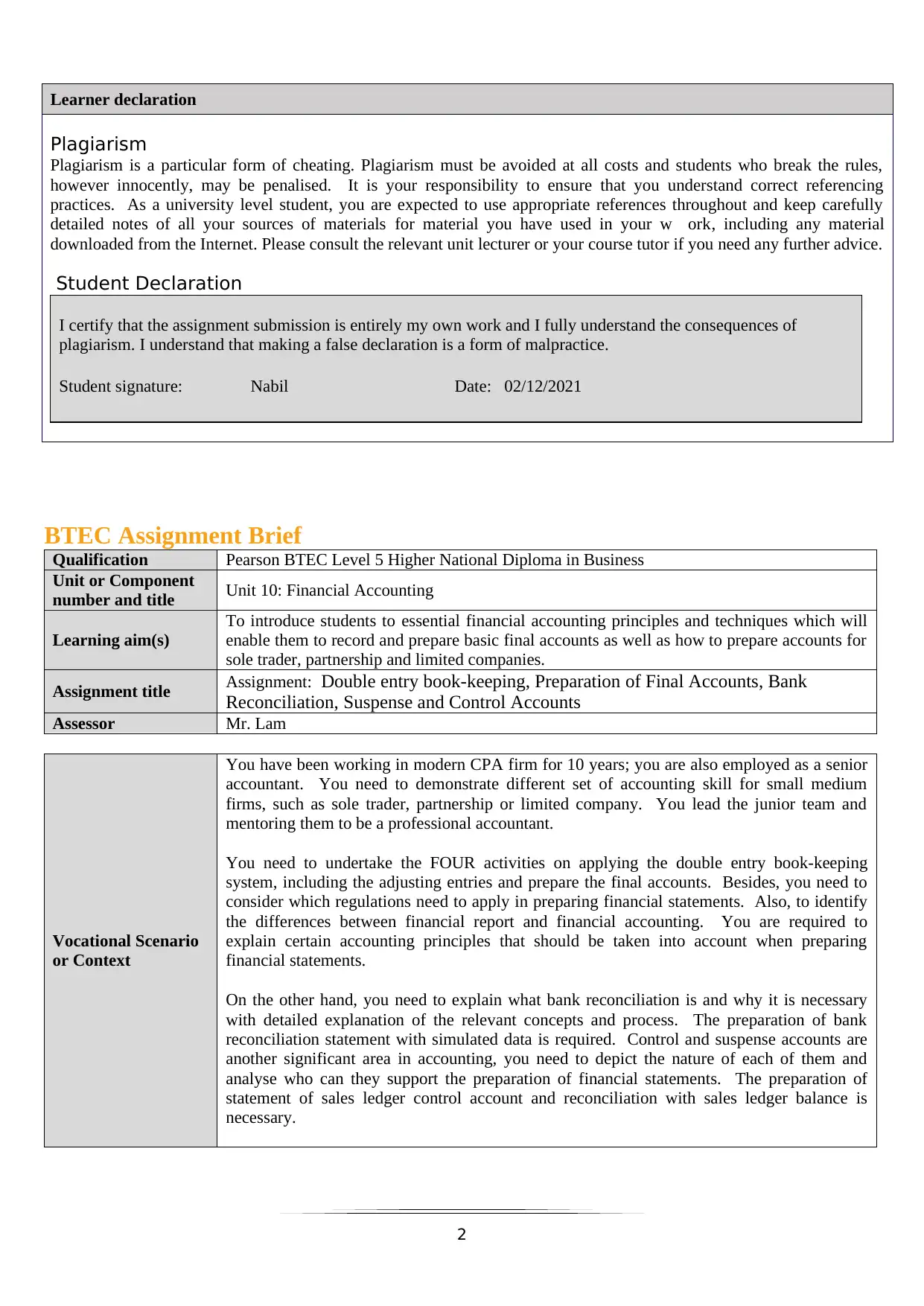
Learner declaration
Plagiarism
Plagiarism is a particular form of cheating. Plagiarism must be avoided at all costs and students who break the rules,
however innocently, may be penalised. It is your responsibility to ensure that you understand correct referencing
practices. As a university level student, you are expected to use appropriate references throughout and keep carefully
detailed notes of all your sources of materials for material you have used in your w ork, including any material
downloaded from the Internet. Please consult the relevant unit lecturer or your course tutor if you need any further advice.
Student Declaration
I certify that the assignment submission is entirely my own work and I fully understand the consequences of
plagiarism. I understand that making a false declaration is a form of malpractice.
Student signature: Nabil Date: 02/12/2021
BTEC Assignment Brief
Qualification Pearson BTEC Level 5 Higher National Diploma in Business
Unit or Component
number and title Unit 10: Financial Accounting
Learning aim(s)
To introduce students to essential financial accounting principles and techniques which will
enable them to record and prepare basic final accounts as well as how to prepare accounts for
sole trader, partnership and limited companies.
Assignment title Assignment: Double entry book-keeping, Preparation of Final Accounts, Bank
Reconciliation, Suspense and Control Accounts
Assessor Mr. Lam
Vocational Scenario
or Context
You have been working in modern CPA firm for 10 years; you are also employed as a senior
accountant. You need to demonstrate different set of accounting skill for small medium
firms, such as sole trader, partnership or limited company. You lead the junior team and
mentoring them to be a professional accountant.
You need to undertake the FOUR activities on applying the double entry book-keeping
system, including the adjusting entries and prepare the final accounts. Besides, you need to
consider which regulations need to apply in preparing financial statements. Also, to identify
the differences between financial report and financial accounting. You are required to
explain certain accounting principles that should be taken into account when preparing
financial statements.
On the other hand, you need to explain what bank reconciliation is and why it is necessary
with detailed explanation of the relevant concepts and process. The preparation of bank
reconciliation statement with simulated data is required. Control and suspense accounts are
another significant area in accounting, you need to depict the nature of each of them and
analyse who can they support the preparation of financial statements. The preparation of
statement of sales ledger control account and reconciliation with sales ledger balance is
necessary.
2
Plagiarism
Plagiarism is a particular form of cheating. Plagiarism must be avoided at all costs and students who break the rules,
however innocently, may be penalised. It is your responsibility to ensure that you understand correct referencing
practices. As a university level student, you are expected to use appropriate references throughout and keep carefully
detailed notes of all your sources of materials for material you have used in your w ork, including any material
downloaded from the Internet. Please consult the relevant unit lecturer or your course tutor if you need any further advice.
Student Declaration
I certify that the assignment submission is entirely my own work and I fully understand the consequences of
plagiarism. I understand that making a false declaration is a form of malpractice.
Student signature: Nabil Date: 02/12/2021
BTEC Assignment Brief
Qualification Pearson BTEC Level 5 Higher National Diploma in Business
Unit or Component
number and title Unit 10: Financial Accounting
Learning aim(s)
To introduce students to essential financial accounting principles and techniques which will
enable them to record and prepare basic final accounts as well as how to prepare accounts for
sole trader, partnership and limited companies.
Assignment title Assignment: Double entry book-keeping, Preparation of Final Accounts, Bank
Reconciliation, Suspense and Control Accounts
Assessor Mr. Lam
Vocational Scenario
or Context
You have been working in modern CPA firm for 10 years; you are also employed as a senior
accountant. You need to demonstrate different set of accounting skill for small medium
firms, such as sole trader, partnership or limited company. You lead the junior team and
mentoring them to be a professional accountant.
You need to undertake the FOUR activities on applying the double entry book-keeping
system, including the adjusting entries and prepare the final accounts. Besides, you need to
consider which regulations need to apply in preparing financial statements. Also, to identify
the differences between financial report and financial accounting. You are required to
explain certain accounting principles that should be taken into account when preparing
financial statements.
On the other hand, you need to explain what bank reconciliation is and why it is necessary
with detailed explanation of the relevant concepts and process. The preparation of bank
reconciliation statement with simulated data is required. Control and suspense accounts are
another significant area in accounting, you need to depict the nature of each of them and
analyse who can they support the preparation of financial statements. The preparation of
statement of sales ledger control account and reconciliation with sales ledger balance is
necessary.
2
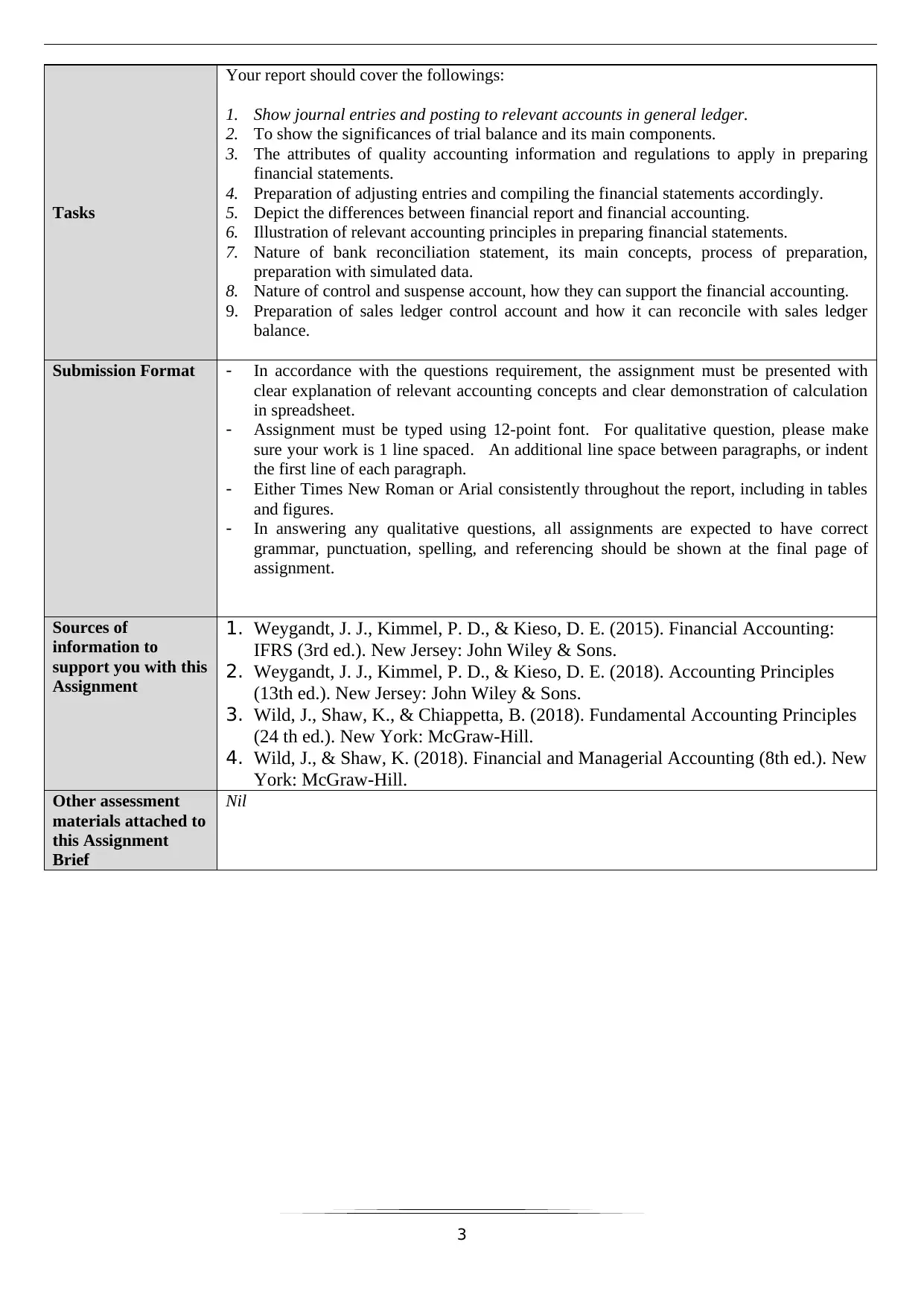
Tasks
Your report should cover the followings:
1. Show journal entries and posting to relevant accounts in general ledger.
2. To show the significances of trial balance and its main components.
3. The attributes of quality accounting information and regulations to apply in preparing
financial statements.
4. Preparation of adjusting entries and compiling the financial statements accordingly.
5. Depict the differences between financial report and financial accounting.
6. Illustration of relevant accounting principles in preparing financial statements.
7. Nature of bank reconciliation statement, its main concepts, process of preparation,
preparation with simulated data.
8. Nature of control and suspense account, how they can support the financial accounting.
9. Preparation of sales ledger control account and how it can reconcile with sales ledger
balance.
Submission Format - In accordance with the questions requirement, the assignment must be presented with
clear explanation of relevant accounting concepts and clear demonstration of calculation
in spreadsheet.
- Assignment must be typed using 12-point font. For qualitative question, please make
sure your work is 1 line spaced. An additional line space between paragraphs, or indent
the first line of each paragraph.
- Either Times New Roman or Arial consistently throughout the report, including in tables
and figures.
- In answering any qualitative questions, all assignments are expected to have correct
grammar, punctuation, spelling, and referencing should be shown at the final page of
assignment.
Sources of
information to
support you with this
Assignment
1. Weygandt, J. J., Kimmel, P. D., & Kieso, D. E. (2015). Financial Accounting:
IFRS (3rd ed.). New Jersey: John Wiley & Sons.
2. Weygandt, J. J., Kimmel, P. D., & Kieso, D. E. (2018). Accounting Principles
(13th ed.). New Jersey: John Wiley & Sons.
3. Wild, J., Shaw, K., & Chiappetta, B. (2018). Fundamental Accounting Principles
(24 th ed.). New York: McGraw-Hill.
4. Wild, J., & Shaw, K. (2018). Financial and Managerial Accounting (8th ed.). New
York: McGraw-Hill.
Other assessment
materials attached to
this Assignment
Brief
Nil
3
Your report should cover the followings:
1. Show journal entries and posting to relevant accounts in general ledger.
2. To show the significances of trial balance and its main components.
3. The attributes of quality accounting information and regulations to apply in preparing
financial statements.
4. Preparation of adjusting entries and compiling the financial statements accordingly.
5. Depict the differences between financial report and financial accounting.
6. Illustration of relevant accounting principles in preparing financial statements.
7. Nature of bank reconciliation statement, its main concepts, process of preparation,
preparation with simulated data.
8. Nature of control and suspense account, how they can support the financial accounting.
9. Preparation of sales ledger control account and how it can reconcile with sales ledger
balance.
Submission Format - In accordance with the questions requirement, the assignment must be presented with
clear explanation of relevant accounting concepts and clear demonstration of calculation
in spreadsheet.
- Assignment must be typed using 12-point font. For qualitative question, please make
sure your work is 1 line spaced. An additional line space between paragraphs, or indent
the first line of each paragraph.
- Either Times New Roman or Arial consistently throughout the report, including in tables
and figures.
- In answering any qualitative questions, all assignments are expected to have correct
grammar, punctuation, spelling, and referencing should be shown at the final page of
assignment.
Sources of
information to
support you with this
Assignment
1. Weygandt, J. J., Kimmel, P. D., & Kieso, D. E. (2015). Financial Accounting:
IFRS (3rd ed.). New Jersey: John Wiley & Sons.
2. Weygandt, J. J., Kimmel, P. D., & Kieso, D. E. (2018). Accounting Principles
(13th ed.). New Jersey: John Wiley & Sons.
3. Wild, J., Shaw, K., & Chiappetta, B. (2018). Fundamental Accounting Principles
(24 th ed.). New York: McGraw-Hill.
4. Wild, J., & Shaw, K. (2018). Financial and Managerial Accounting (8th ed.). New
York: McGraw-Hill.
Other assessment
materials attached to
this Assignment
Brief
Nil
3
⊘ This is a preview!⊘
Do you want full access?
Subscribe today to unlock all pages.

Trusted by 1+ million students worldwide
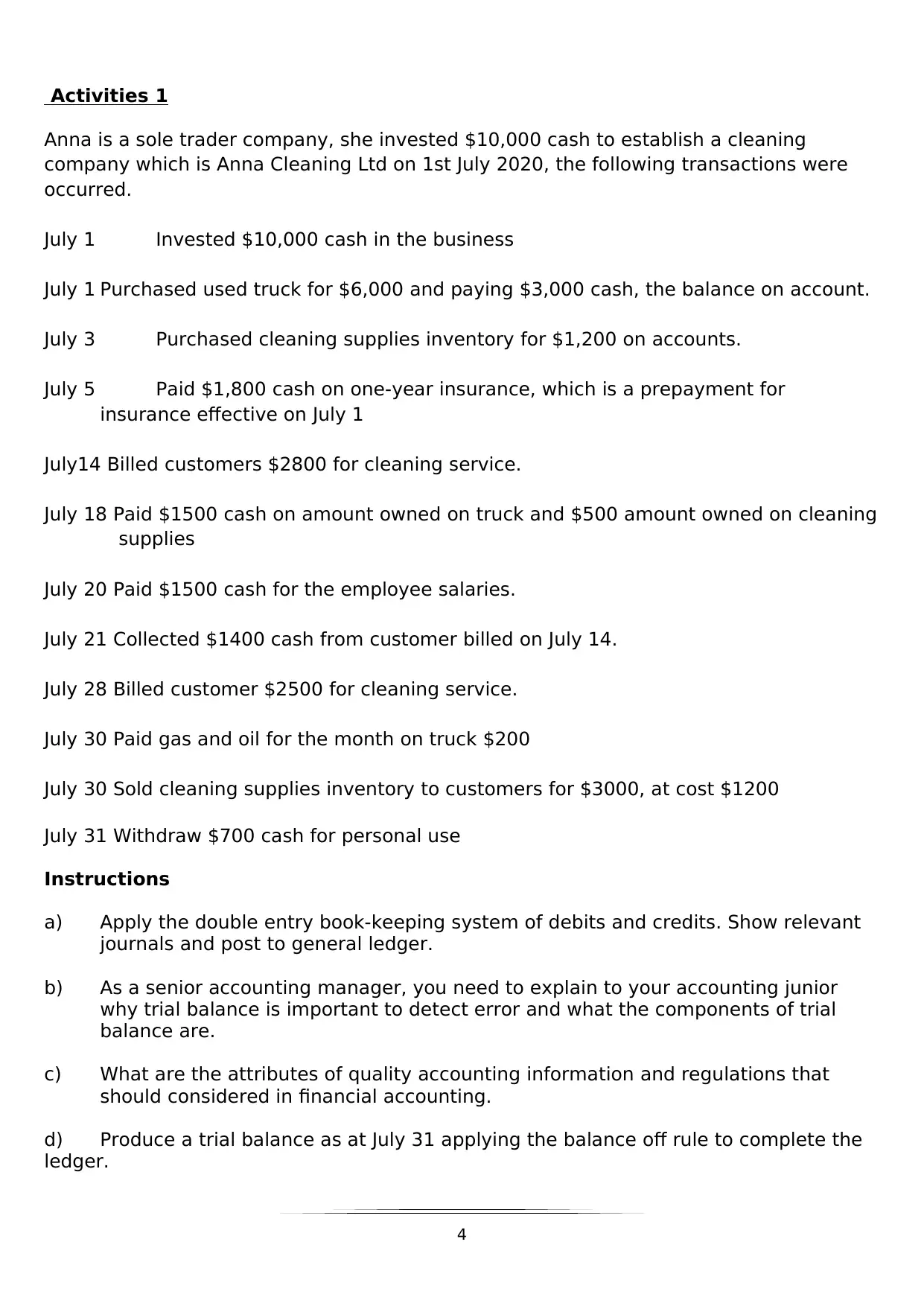
Activities 1
Anna is a sole trader company, she invested $10,000 cash to establish a cleaning
company which is Anna Cleaning Ltd on 1st July 2020, the following transactions were
occurred.
July 1 Invested $10,000 cash in the business
July 1 Purchased used truck for $6,000 and paying $3,000 cash, the balance on account.
July 3 Purchased cleaning supplies inventory for $1,200 on accounts.
July 5 Paid $1,800 cash on one-year insurance, which is a prepayment for
insurance effective on July 1
July14 Billed customers $2800 for cleaning service.
July 18 Paid $1500 cash on amount owned on truck and $500 amount owned on cleaning
supplies
July 20 Paid $1500 cash for the employee salaries.
July 21 Collected $1400 cash from customer billed on July 14.
July 28 Billed customer $2500 for cleaning service.
July 30 Paid gas and oil for the month on truck $200
July 30 Sold cleaning supplies inventory to customers for $3000, at cost $1200
July 31 Withdraw $700 cash for personal use
Instructions
a) Apply the double entry book-keeping system of debits and credits. Show relevant
journals and post to general ledger.
b) As a senior accounting manager, you need to explain to your accounting junior
why trial balance is important to detect error and what the components of trial
balance are.
c) What are the attributes of quality accounting information and regulations that
should considered in financial accounting.
d) Produce a trial balance as at July 31 applying the balance off rule to complete the
ledger.
4
Anna is a sole trader company, she invested $10,000 cash to establish a cleaning
company which is Anna Cleaning Ltd on 1st July 2020, the following transactions were
occurred.
July 1 Invested $10,000 cash in the business
July 1 Purchased used truck for $6,000 and paying $3,000 cash, the balance on account.
July 3 Purchased cleaning supplies inventory for $1,200 on accounts.
July 5 Paid $1,800 cash on one-year insurance, which is a prepayment for
insurance effective on July 1
July14 Billed customers $2800 for cleaning service.
July 18 Paid $1500 cash on amount owned on truck and $500 amount owned on cleaning
supplies
July 20 Paid $1500 cash for the employee salaries.
July 21 Collected $1400 cash from customer billed on July 14.
July 28 Billed customer $2500 for cleaning service.
July 30 Paid gas and oil for the month on truck $200
July 30 Sold cleaning supplies inventory to customers for $3000, at cost $1200
July 31 Withdraw $700 cash for personal use
Instructions
a) Apply the double entry book-keeping system of debits and credits. Show relevant
journals and post to general ledger.
b) As a senior accounting manager, you need to explain to your accounting junior
why trial balance is important to detect error and what the components of trial
balance are.
c) What are the attributes of quality accounting information and regulations that
should considered in financial accounting.
d) Produce a trial balance as at July 31 applying the balance off rule to complete the
ledger.
4
Paraphrase This Document
Need a fresh take? Get an instant paraphrase of this document with our AI Paraphraser
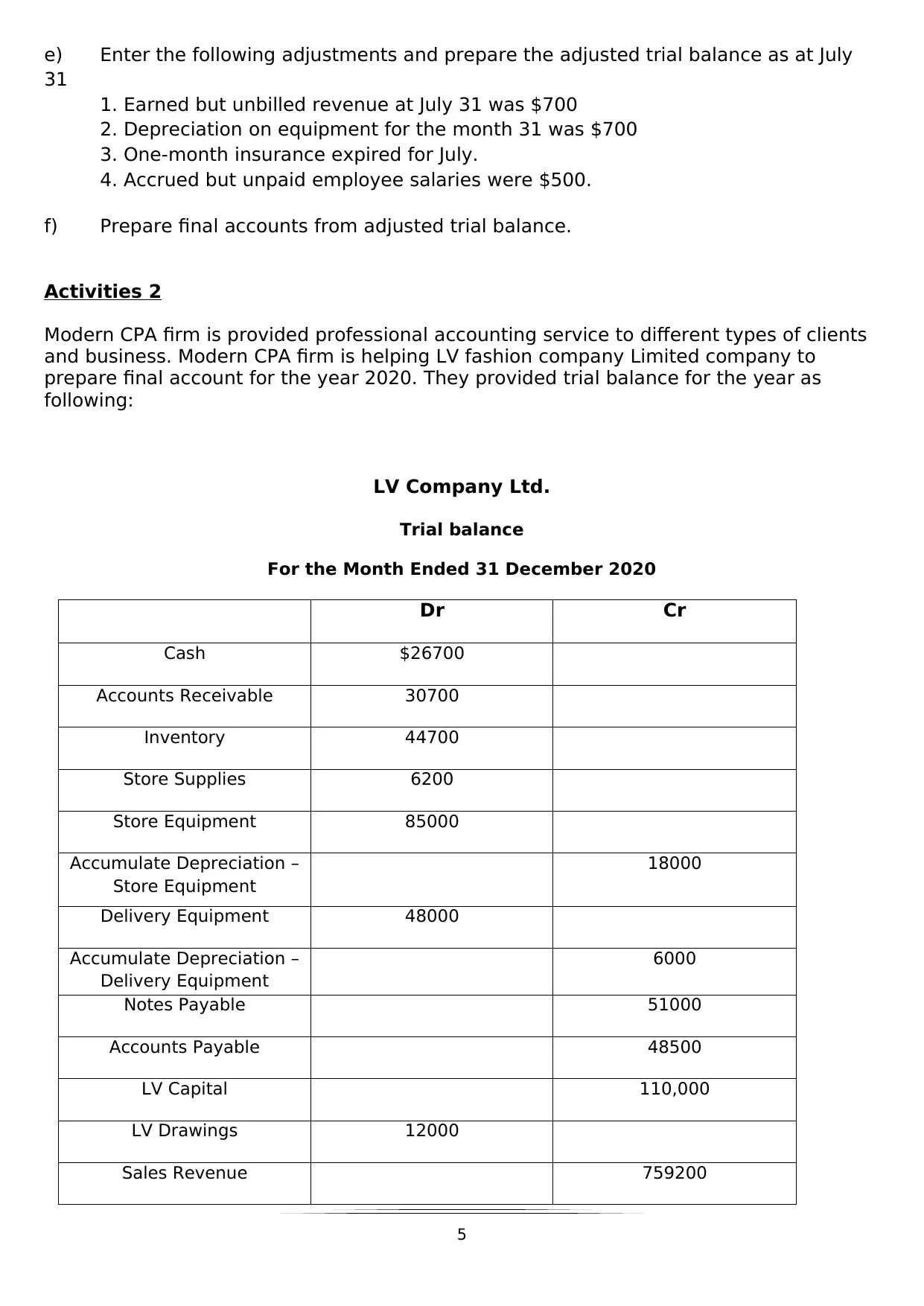
e) Enter the following adjustments and prepare the adjusted trial balance as at July
31
1. Earned but unbilled revenue at July 31 was $700
2. Depreciation on equipment for the month 31 was $700
3. One-month insurance expired for July.
4. Accrued but unpaid employee salaries were $500.
f) Prepare final accounts from adjusted trial balance.
Activities 2
Modern CPA firm is provided professional accounting service to different types of clients
and business. Modern CPA firm is helping LV fashion company Limited company to
prepare final account for the year 2020. They provided trial balance for the year as
following:
LV Company Ltd.
Trial balance
For the Month Ended 31 December 2020
Dr Cr
Cash $26700
Accounts Receivable 30700
Inventory 44700
Store Supplies 6200
Store Equipment 85000
Accumulate Depreciation –
Store Equipment
18000
Delivery Equipment 48000
Accumulate Depreciation –
Delivery Equipment
6000
Notes Payable 51000
Accounts Payable 48500
LV Capital 110,000
LV Drawings 12000
Sales Revenue 759200
5
31
1. Earned but unbilled revenue at July 31 was $700
2. Depreciation on equipment for the month 31 was $700
3. One-month insurance expired for July.
4. Accrued but unpaid employee salaries were $500.
f) Prepare final accounts from adjusted trial balance.
Activities 2
Modern CPA firm is provided professional accounting service to different types of clients
and business. Modern CPA firm is helping LV fashion company Limited company to
prepare final account for the year 2020. They provided trial balance for the year as
following:
LV Company Ltd.
Trial balance
For the Month Ended 31 December 2020
Dr Cr
Cash $26700
Accounts Receivable 30700
Inventory 44700
Store Supplies 6200
Store Equipment 85000
Accumulate Depreciation –
Store Equipment
18000
Delivery Equipment 48000
Accumulate Depreciation –
Delivery Equipment
6000
Notes Payable 51000
Accounts Payable 48500
LV Capital 110,000
LV Drawings 12000
Sales Revenue 759200
5
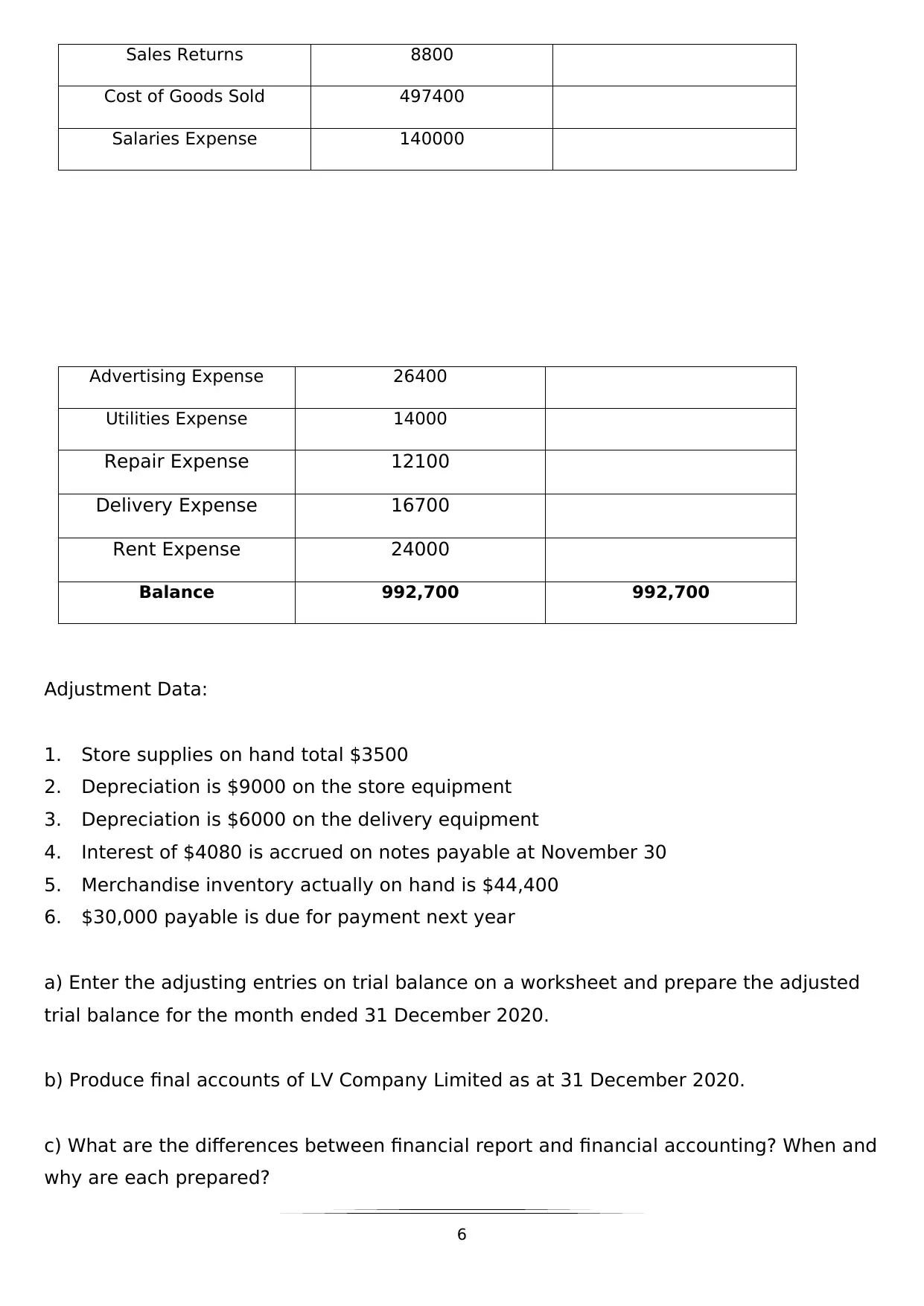
Sales Returns 8800
Cost of Goods Sold 497400
Salaries Expense 140000
Advertising Expense 26400
Utilities Expense 14000
Repair Expense 12100
Delivery Expense 16700
Rent Expense 24000
Balance 992,700 992,700
Adjustment Data:
1. Store supplies on hand total $3500
2. Depreciation is $9000 on the store equipment
3. Depreciation is $6000 on the delivery equipment
4. Interest of $4080 is accrued on notes payable at November 30
5. Merchandise inventory actually on hand is $44,400
6. $30,000 payable is due for payment next year
a) Enter the adjusting entries on trial balance on a worksheet and prepare the adjusted
trial balance for the month ended 31 December 2020.
b) Produce final accounts of LV Company Limited as at 31 December 2020.
c) What are the differences between financial report and financial accounting? When and
why are each prepared?
6
Cost of Goods Sold 497400
Salaries Expense 140000
Advertising Expense 26400
Utilities Expense 14000
Repair Expense 12100
Delivery Expense 16700
Rent Expense 24000
Balance 992,700 992,700
Adjustment Data:
1. Store supplies on hand total $3500
2. Depreciation is $9000 on the store equipment
3. Depreciation is $6000 on the delivery equipment
4. Interest of $4080 is accrued on notes payable at November 30
5. Merchandise inventory actually on hand is $44,400
6. $30,000 payable is due for payment next year
a) Enter the adjusting entries on trial balance on a worksheet and prepare the adjusted
trial balance for the month ended 31 December 2020.
b) Produce final accounts of LV Company Limited as at 31 December 2020.
c) What are the differences between financial report and financial accounting? When and
why are each prepared?
6
⊘ This is a preview!⊘
Do you want full access?
Subscribe today to unlock all pages.

Trusted by 1+ million students worldwide
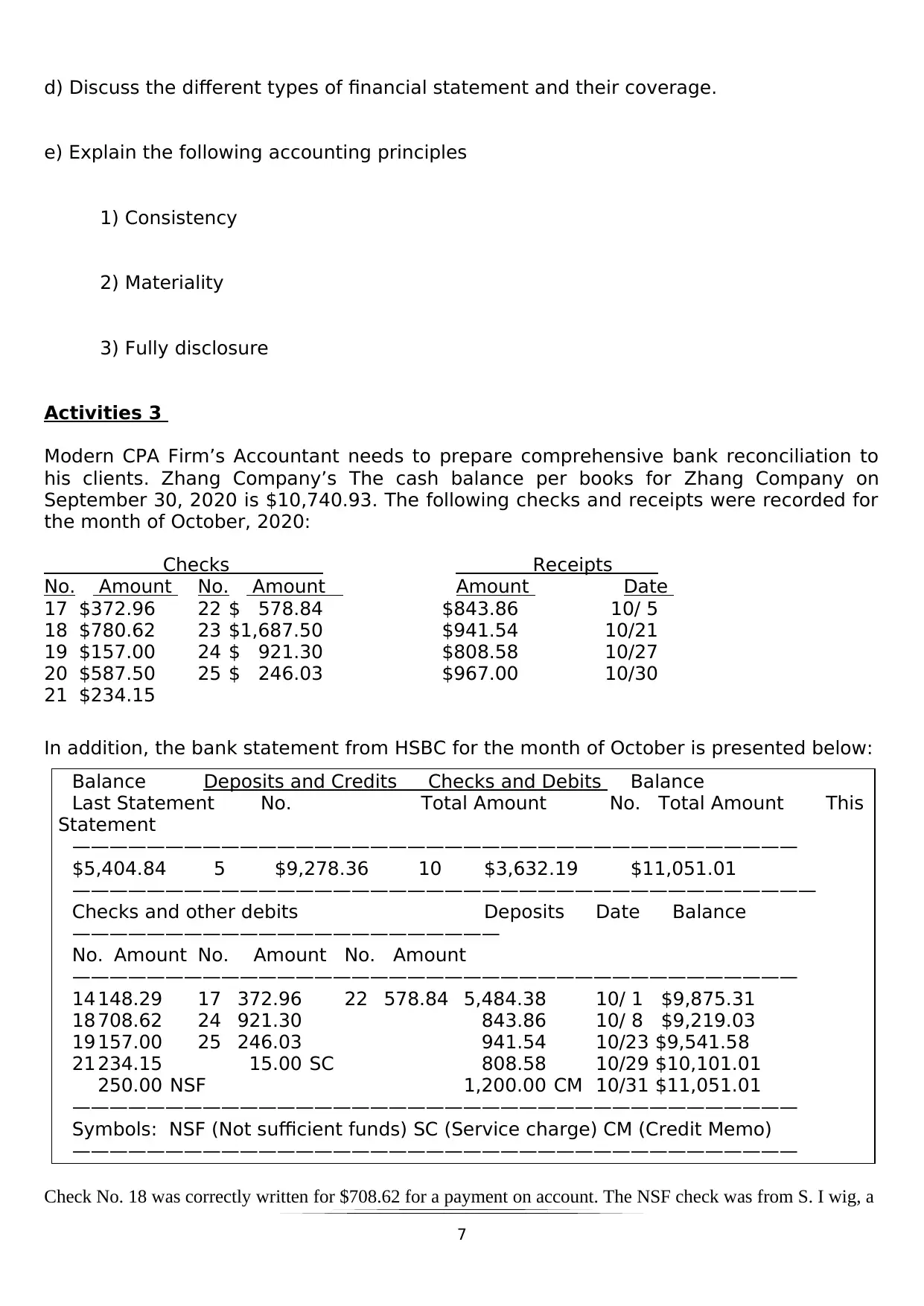
d) Discuss the different types of financial statement and their coverage.
e) Explain the following accounting principles
1) Consistency
2) Materiality
3) Fully disclosure
Activities 3
Modern CPA Firm’s Accountant needs to prepare comprehensive bank reconciliation to
his clients. Zhang Company’s The cash balance per books for Zhang Company on
September 30, 2020 is $10,740.93. The following checks and receipts were recorded for
the month of October, 2020:
Checks Receipts
No. Amount No. Amount Amount Date
17 $372.96 22 $ 578.84 $843.86 10/ 5
18 $780.62 23 $1,687.50 $941.54 10/21
19 $157.00 24 $ 921.30 $808.58 10/27
20 $587.50 25 $ 246.03 $967.00 10/30
21 $234.15
In addition, the bank statement from HSBC for the month of October is presented below:
Balance Deposits and Credits Checks and Debits Balance
Last Statement No. Total Amount No. Total Amount This
Statement
———————————————————————————————————————
$5,404.84 5 $9,278.36 10 $3,632.19 $11,051.01
————————————————————————————————————————
Checks and other debits Deposits Date Balance
———————————————————————
No. Amount No. Amount No. Amount
———————————————————————————————————————
14 148.29 17 372.96 22 578.84 5,484.38 10/ 1 $9,875.31
18 708.62 24 921.30 843.86 10/ 8 $9,219.03
19 157.00 25 246.03 941.54 10/23 $9,541.58
21 234.15 15.00 SC 808.58 10/29 $10,101.01
250.00 NSF 1,200.00 CM 10/31 $11,051.01
———————————————————————————————————————
Symbols: NSF (Not sufficient funds) SC (Service charge) CM (Credit Memo)
———————————————————————————————————————
Check No. 18 was correctly written for $708.62 for a payment on account. The NSF check was from S. I wig, a
7
e) Explain the following accounting principles
1) Consistency
2) Materiality
3) Fully disclosure
Activities 3
Modern CPA Firm’s Accountant needs to prepare comprehensive bank reconciliation to
his clients. Zhang Company’s The cash balance per books for Zhang Company on
September 30, 2020 is $10,740.93. The following checks and receipts were recorded for
the month of October, 2020:
Checks Receipts
No. Amount No. Amount Amount Date
17 $372.96 22 $ 578.84 $843.86 10/ 5
18 $780.62 23 $1,687.50 $941.54 10/21
19 $157.00 24 $ 921.30 $808.58 10/27
20 $587.50 25 $ 246.03 $967.00 10/30
21 $234.15
In addition, the bank statement from HSBC for the month of October is presented below:
Balance Deposits and Credits Checks and Debits Balance
Last Statement No. Total Amount No. Total Amount This
Statement
———————————————————————————————————————
$5,404.84 5 $9,278.36 10 $3,632.19 $11,051.01
————————————————————————————————————————
Checks and other debits Deposits Date Balance
———————————————————————
No. Amount No. Amount No. Amount
———————————————————————————————————————
14 148.29 17 372.96 22 578.84 5,484.38 10/ 1 $9,875.31
18 708.62 24 921.30 843.86 10/ 8 $9,219.03
19 157.00 25 246.03 941.54 10/23 $9,541.58
21 234.15 15.00 SC 808.58 10/29 $10,101.01
250.00 NSF 1,200.00 CM 10/31 $11,051.01
———————————————————————————————————————
Symbols: NSF (Not sufficient funds) SC (Service charge) CM (Credit Memo)
———————————————————————————————————————
Check No. 18 was correctly written for $708.62 for a payment on account. The NSF check was from S. I wig, a
7
Paraphrase This Document
Need a fresh take? Get an instant paraphrase of this document with our AI Paraphraser
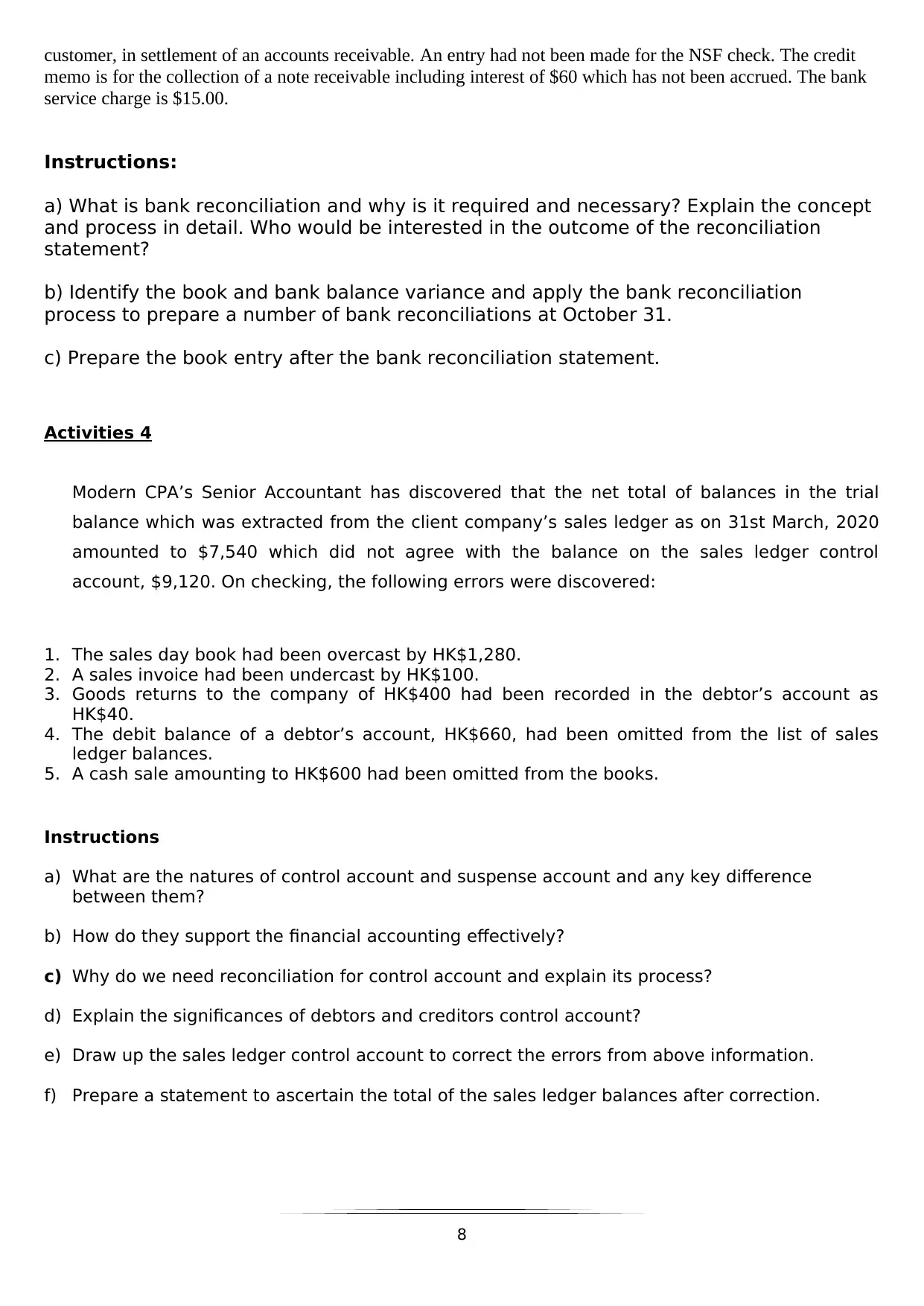
customer, in settlement of an accounts receivable. An entry had not been made for the NSF check. The credit
memo is for the collection of a note receivable including interest of $60 which has not been accrued. The bank
service charge is $15.00.
Instructions:
a) What is bank reconciliation and why is it required and necessary? Explain the concept
and process in detail. Who would be interested in the outcome of the reconciliation
statement?
b) Identify the book and bank balance variance and apply the bank reconciliation
process to prepare a number of bank reconciliations at October 31.
c) Prepare the book entry after the bank reconciliation statement.
Activities 4
Modern CPA’s Senior Accountant has discovered that the net total of balances in the trial
balance which was extracted from the client company’s sales ledger as on 31st March, 2020
amounted to $7,540 which did not agree with the balance on the sales ledger control
account, $9,120. On checking, the following errors were discovered:
1. The sales day book had been overcast by HK$1,280.
2. A sales invoice had been undercast by HK$100.
3. Goods returns to the company of HK$400 had been recorded in the debtor’s account as
HK$40.
4. The debit balance of a debtor’s account, HK$660, had been omitted from the list of sales
ledger balances.
5. A cash sale amounting to HK$600 had been omitted from the books.
Instructions
a) What are the natures of control account and suspense account and any key difference
between them?
b) How do they support the financial accounting effectively?
c) Why do we need reconciliation for control account and explain its process?
d) Explain the significances of debtors and creditors control account?
e) Draw up the sales ledger control account to correct the errors from above information.
f) Prepare a statement to ascertain the total of the sales ledger balances after correction.
8
memo is for the collection of a note receivable including interest of $60 which has not been accrued. The bank
service charge is $15.00.
Instructions:
a) What is bank reconciliation and why is it required and necessary? Explain the concept
and process in detail. Who would be interested in the outcome of the reconciliation
statement?
b) Identify the book and bank balance variance and apply the bank reconciliation
process to prepare a number of bank reconciliations at October 31.
c) Prepare the book entry after the bank reconciliation statement.
Activities 4
Modern CPA’s Senior Accountant has discovered that the net total of balances in the trial
balance which was extracted from the client company’s sales ledger as on 31st March, 2020
amounted to $7,540 which did not agree with the balance on the sales ledger control
account, $9,120. On checking, the following errors were discovered:
1. The sales day book had been overcast by HK$1,280.
2. A sales invoice had been undercast by HK$100.
3. Goods returns to the company of HK$400 had been recorded in the debtor’s account as
HK$40.
4. The debit balance of a debtor’s account, HK$660, had been omitted from the list of sales
ledger balances.
5. A cash sale amounting to HK$600 had been omitted from the books.
Instructions
a) What are the natures of control account and suspense account and any key difference
between them?
b) How do they support the financial accounting effectively?
c) Why do we need reconciliation for control account and explain its process?
d) Explain the significances of debtors and creditors control account?
e) Draw up the sales ledger control account to correct the errors from above information.
f) Prepare a statement to ascertain the total of the sales ledger balances after correction.
8
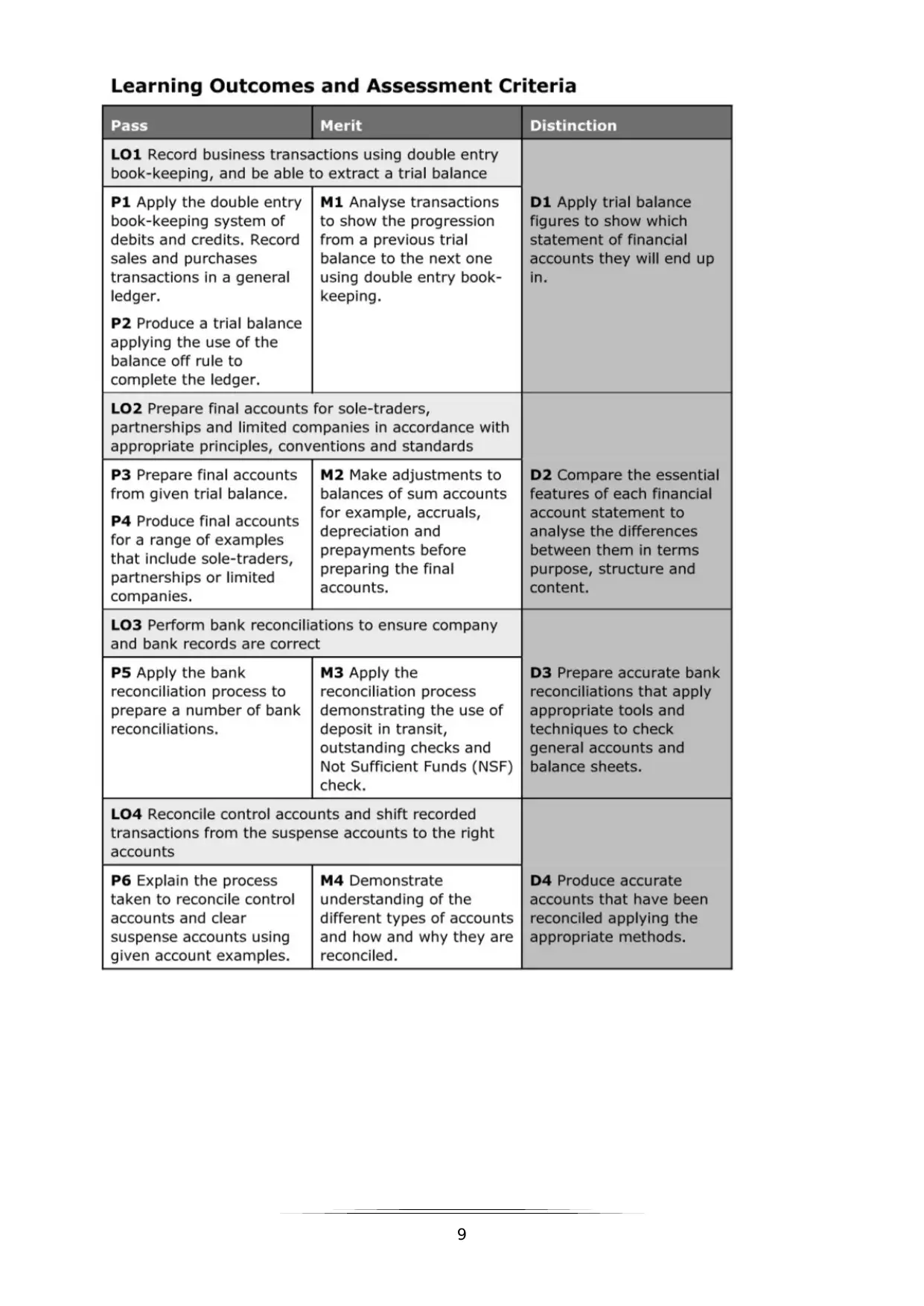
9
⊘ This is a preview!⊘
Do you want full access?
Subscribe today to unlock all pages.

Trusted by 1+ million students worldwide
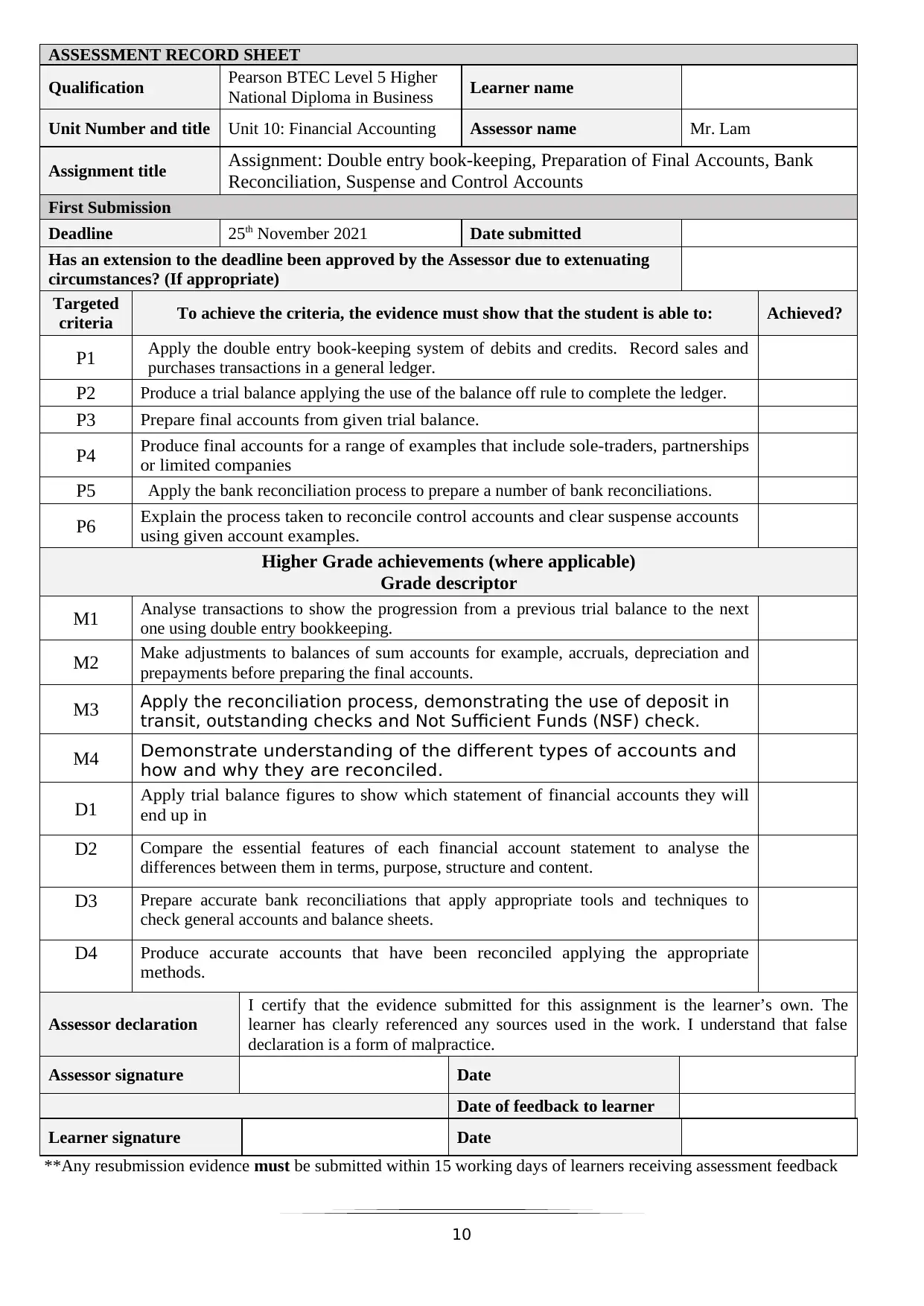
ASSESSMENT RECORD SHEET
Qualification Pearson BTEC Level 5 Higher
National Diploma in Business Learner name
Unit Number and title Unit 10: Financial Accounting Assessor name Mr. Lam
Assignment title Assignment: Double entry book-keeping, Preparation of Final Accounts, Bank
Reconciliation, Suspense and Control Accounts
First Submission
Deadline 25th November 2021 Date submitted
Has an extension to the deadline been approved by the Assessor due to extenuating
circumstances? (If appropriate)
Targeted
criteria To achieve the criteria, the evidence must show that the student is able to: Achieved?
P1 Apply the double entry book-keeping system of debits and credits. Record sales and
purchases transactions in a general ledger.
P2 Produce a trial balance applying the use of the balance off rule to complete the ledger.
P3 Prepare final accounts from given trial balance.
P4 Produce final accounts for a range of examples that include sole-traders, partnerships
or limited companies
P5 Apply the bank reconciliation process to prepare a number of bank reconciliations.
P6 Explain the process taken to reconcile control accounts and clear suspense accounts
using given account examples.
Higher Grade achievements (where applicable)
Grade descriptor
M1 Analyse transactions to show the progression from a previous trial balance to the next
one using double entry bookkeeping.
M2 Make adjustments to balances of sum accounts for example, accruals, depreciation and
prepayments before preparing the final accounts.
M3 Apply the reconciliation process, demonstrating the use of deposit in
transit, outstanding checks and Not Sufficient Funds (NSF) check.
M4 Demonstrate understanding of the different types of accounts and
how and why they are reconciled.
D1 Apply trial balance figures to show which statement of financial accounts they will
end up in
D2 Compare the essential features of each financial account statement to analyse the
differences between them in terms, purpose, structure and content.
D3 Prepare accurate bank reconciliations that apply appropriate tools and techniques to
check general accounts and balance sheets.
D4 Produce accurate accounts that have been reconciled applying the appropriate
methods.
Assessor declaration
I certify that the evidence submitted for this assignment is the learner’s own. The
learner has clearly referenced any sources used in the work. I understand that false
declaration is a form of malpractice.
Assessor signature Date
Date of feedback to learner
Learner signature Date
**Any resubmission evidence must be submitted within 15 working days of learners receiving assessment feedback
10
Qualification Pearson BTEC Level 5 Higher
National Diploma in Business Learner name
Unit Number and title Unit 10: Financial Accounting Assessor name Mr. Lam
Assignment title Assignment: Double entry book-keeping, Preparation of Final Accounts, Bank
Reconciliation, Suspense and Control Accounts
First Submission
Deadline 25th November 2021 Date submitted
Has an extension to the deadline been approved by the Assessor due to extenuating
circumstances? (If appropriate)
Targeted
criteria To achieve the criteria, the evidence must show that the student is able to: Achieved?
P1 Apply the double entry book-keeping system of debits and credits. Record sales and
purchases transactions in a general ledger.
P2 Produce a trial balance applying the use of the balance off rule to complete the ledger.
P3 Prepare final accounts from given trial balance.
P4 Produce final accounts for a range of examples that include sole-traders, partnerships
or limited companies
P5 Apply the bank reconciliation process to prepare a number of bank reconciliations.
P6 Explain the process taken to reconcile control accounts and clear suspense accounts
using given account examples.
Higher Grade achievements (where applicable)
Grade descriptor
M1 Analyse transactions to show the progression from a previous trial balance to the next
one using double entry bookkeeping.
M2 Make adjustments to balances of sum accounts for example, accruals, depreciation and
prepayments before preparing the final accounts.
M3 Apply the reconciliation process, demonstrating the use of deposit in
transit, outstanding checks and Not Sufficient Funds (NSF) check.
M4 Demonstrate understanding of the different types of accounts and
how and why they are reconciled.
D1 Apply trial balance figures to show which statement of financial accounts they will
end up in
D2 Compare the essential features of each financial account statement to analyse the
differences between them in terms, purpose, structure and content.
D3 Prepare accurate bank reconciliations that apply appropriate tools and techniques to
check general accounts and balance sheets.
D4 Produce accurate accounts that have been reconciled applying the appropriate
methods.
Assessor declaration
I certify that the evidence submitted for this assignment is the learner’s own. The
learner has clearly referenced any sources used in the work. I understand that false
declaration is a form of malpractice.
Assessor signature Date
Date of feedback to learner
Learner signature Date
**Any resubmission evidence must be submitted within 15 working days of learners receiving assessment feedback
10
Paraphrase This Document
Need a fresh take? Get an instant paraphrase of this document with our AI Paraphraser
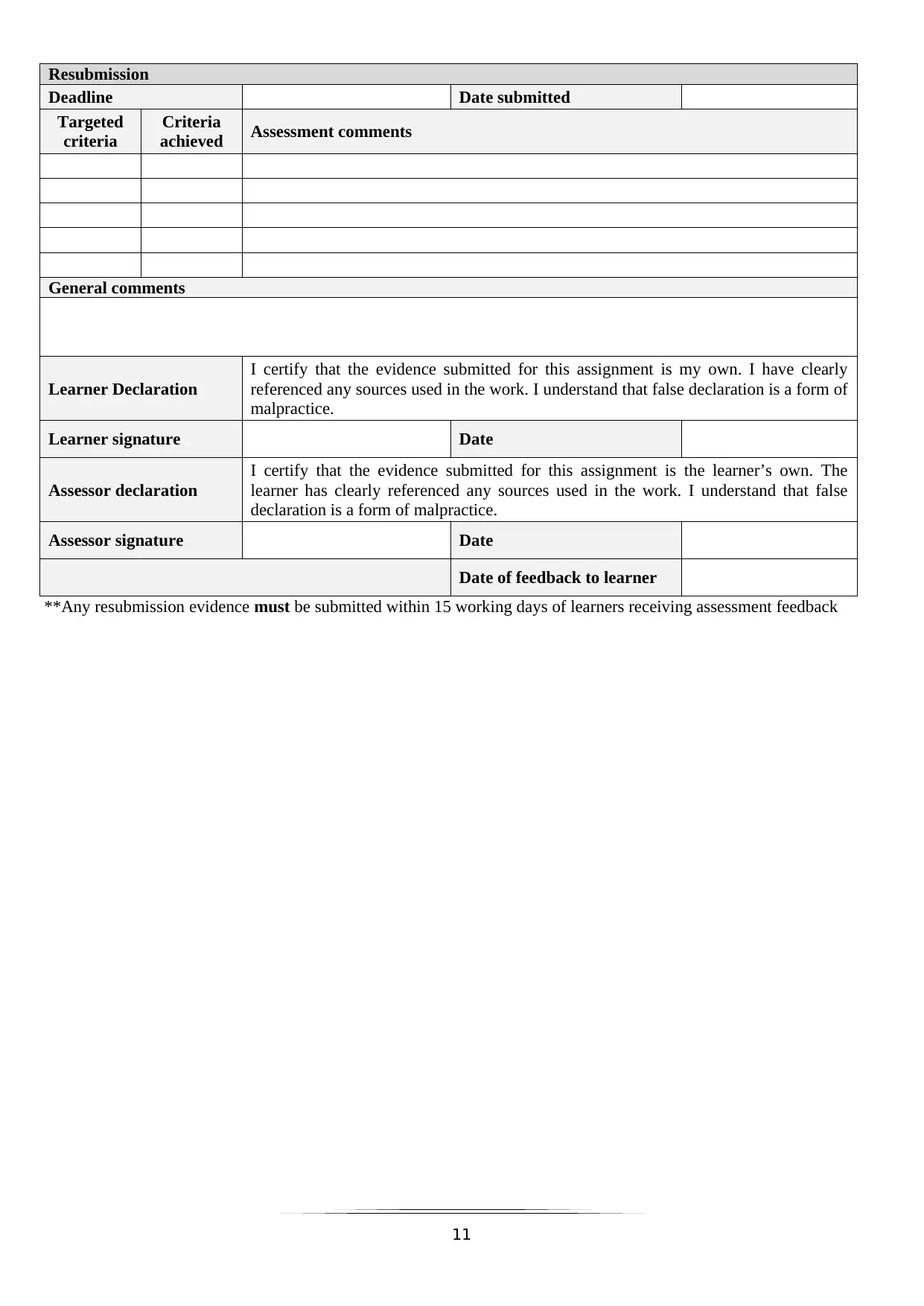
Resubmission
Deadline Date submitted
Targeted
criteria
Criteria
achieved Assessment comments
General comments
Learner Declaration
I certify that the evidence submitted for this assignment is my own. I have clearly
referenced any sources used in the work. I understand that false declaration is a form of
malpractice.
Learner signature Date
Assessor declaration
I certify that the evidence submitted for this assignment is the learner’s own. The
learner has clearly referenced any sources used in the work. I understand that false
declaration is a form of malpractice.
Assessor signature Date
Date of feedback to learner
**Any resubmission evidence must be submitted within 15 working days of learners receiving assessment feedback
11
Deadline Date submitted
Targeted
criteria
Criteria
achieved Assessment comments
General comments
Learner Declaration
I certify that the evidence submitted for this assignment is my own. I have clearly
referenced any sources used in the work. I understand that false declaration is a form of
malpractice.
Learner signature Date
Assessor declaration
I certify that the evidence submitted for this assignment is the learner’s own. The
learner has clearly referenced any sources used in the work. I understand that false
declaration is a form of malpractice.
Assessor signature Date
Date of feedback to learner
**Any resubmission evidence must be submitted within 15 working days of learners receiving assessment feedback
11
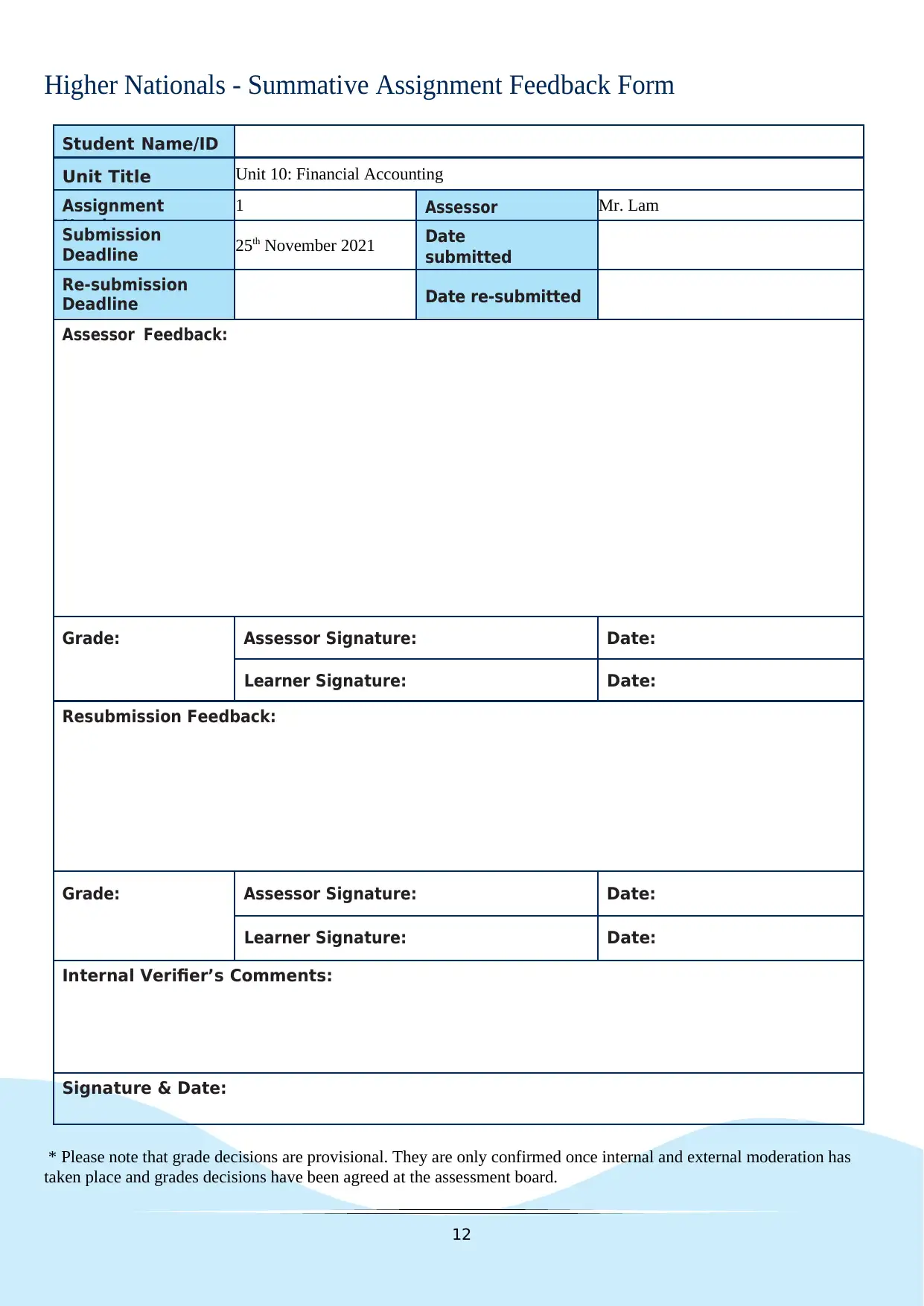
Higher Nationals - Summative Assignment Feedback Form
Student Name/ID
Unit Title Unit 10: Financial Accounting
Assignment
Number
1 Assessor Mr. Lam
Submission
Deadline 25th November 2021 Date
submitted
Re-submission
Deadline Date re-submitted
Assessor Feedback:
Grade: Assessor Signature: Date:
Learner Signature: Date:
Resubmission Feedback:
Grade: Assessor Signature: Date:
Learner Signature: Date:
Internal Verifier’s Comments:
Signature & Date:
* Please note that grade decisions are provisional. They are only confirmed once internal and external moderation has
taken place and grades decisions have been agreed at the assessment board.
12
Student Name/ID
Unit Title Unit 10: Financial Accounting
Assignment
Number
1 Assessor Mr. Lam
Submission
Deadline 25th November 2021 Date
submitted
Re-submission
Deadline Date re-submitted
Assessor Feedback:
Grade: Assessor Signature: Date:
Learner Signature: Date:
Resubmission Feedback:
Grade: Assessor Signature: Date:
Learner Signature: Date:
Internal Verifier’s Comments:
Signature & Date:
* Please note that grade decisions are provisional. They are only confirmed once internal and external moderation has
taken place and grades decisions have been agreed at the assessment board.
12
⊘ This is a preview!⊘
Do you want full access?
Subscribe today to unlock all pages.

Trusted by 1+ million students worldwide
1 out of 33
Related Documents
Your All-in-One AI-Powered Toolkit for Academic Success.
+13062052269
info@desklib.com
Available 24*7 on WhatsApp / Email
![[object Object]](/_next/static/media/star-bottom.7253800d.svg)
Unlock your academic potential
Copyright © 2020–2025 A2Z Services. All Rights Reserved. Developed and managed by ZUCOL.





